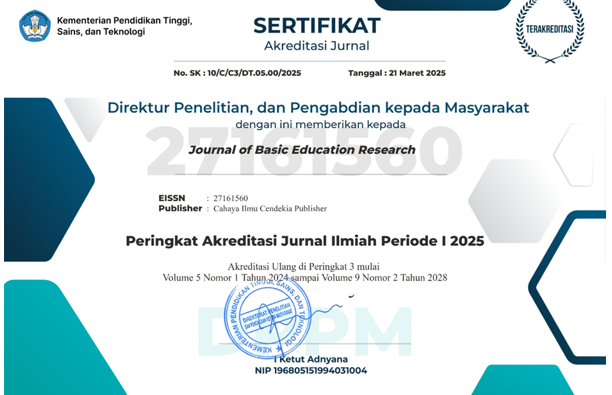Innovation of Fiqh Learning Through Talking Stick to Increase Students' Learning Motivation in Elementary Madrasahs
Abstract
Purpose of the study: Learning motivation is crucial to the process's effectiveness, particularly regarding Fiqh, a subject that requires a thorough comprehension of Islamic ideas. However, the lack of active engagement and attention to learning in class VI at Elementary Madrasahs actually indicates low learning desire among the pupils. Using the Talking Stick approach, this study seeks to increase students' motivation to learn the topic of Fiqh.
Methodology: The planning, execution, observation, and reflection phases make up each of the two cycles of this Classroom Action Research (CAR) project. Fifteen seventh-grade students from Elementary Madrasahs were the study's subjects.
Main Findings: The study's findings demonstrated that using the Talking Stick technique can increase students' learning enthusiasm. The average percentage of students' learning motivation in cycle I was 81.71% (good category); in cycle II, it rose to 92.65% (outstanding category). Meanwhile, the learning outcomes increased as expected, averaging 81.80 in cycle I and 86,20 in cycle 2. According to the study's findings, using the Talking Stick method can effectively increase students' motivation to learn Fiqh.
Novelty/Originality of this study: According to the study, educators can use this technique as a substitute for engaging and interactive instruction while continuing to create new active learning strategies to raise the standard of instruction in the classroom.
References
E. Suncaka, “Meninjau permasalahan rendahnya kualitas pendidikan di Indonesia,” Unisan J., vol. 2, no. 3, pp. 36–49, 2023,
D. A. Dewi and R. F. Anjanie, “Peran media pembelajaran dalam upaya meningkatkan motivasi belajar peserta didik kelas V SD IT Bunayya,” J. Pendidik. dan Kebud., vol. 3, no. 2, pp. 179–185, 2023,
V. D. Tran, “Does cooperative learning increase students’ motivation in learning?,” Int. J. High. Educ., vol. 8, no. 5, pp. 12–20, 2019, doi: 10.5430/ijhe.v8n5p12.
Z. Nadya and R. Pustika, “The importance of family motivation for student to study online during the Covid-19,” J. English Lang. Teach. Learn., vol. 2, no. 2, pp. 86–89, 2021, doi: 10.33365/jeltl.v2i2.1214.
N. Makrifah and N. Fauzi, “Implementation of talking stick learning model to improve english learning outcomes in islamic elementary school,” Fikroh J. Pemikir. dan Pendidik. Islam, vol. 17, no. 1, pp. 29–39, 2024, doi: 10.37812/fikroh.v17i1.1403.
I. Ahn, M. M. Chiu, and H. Patrick, “Connecting teacher and student motivation: Student-perceived teacher need-supportive practices and student need satisfaction,” Contemp. Educ. Psychol., vol. 64, no. January, 2021, doi: 10.1016/j.cedpsych.2021.101950.
S. Islam, C. Muali, and I. M. Ghufron, Moh Idil, “To boost students ’ motivation and achievement through blended learning to boost students ’ motivation and achievement through blended learning,” J. Phys. Conf. Ser., vol. 1114, pp. 1–11, 2018, [Online]. Available: https://iopscience.iop.org/article/10.1088/1742-6596/1114/1/012046/meta
E. Pujiharti, “Peran sumber daya pendidik dalam perspektif ekonomi pendidikan,” AN NAHDLIYYAH, vol. 1, no. 2, pp. 35–50, 2022, [Online]. Available: https://ejournal.stainu-malang.ac.id/index.php/annahdliyah/article/view/40
P. R. A. Pintrich, “Beyond ‘cold’ Conceptual change: the role of motivational beliefs and classroom contextual factors in the process of conceptual change,” Rev. Educ. Res., vol. 63, pp. 167–199, 1993.
Alhamdu, “Interest and reading motivationt,” PSIKIS-Jurnal Psikol. Islam., vol. 1, no. 1, pp. 1–10, 2016, [Online]. Available: https://www.researchgate.net/publication/323576174_INTEREST_AND_READING_MOTIVATION
M. Reresi, “Implikasi prinsip belajar aktif bagi guru dan peserta didik dalam pembelajaran agama,” Logos J. Pendidikan, Katekese, dan Pastor., vol. 10, no. 1, 2022, [Online]. Available: https://ejournal-stpakambon.id/index.php/JL/article/view/24
Z. Fajri, H. Baharun, C. Muali, Shofiatun, L. Farida, and Y. Wahyuningtiyas, “Student’s learning motivation and interest; the effectiveness of online learning during COVID-19 Pandemic,” J. Phys. Conf. Ser., vol. 1899, no. 1, 2021, doi: 10.1088/1742-6596/1899/1/012178.
Fajri Zaenol; Syaidatul Mukaroma, “Pendidikan akhlak perspektif al ghazali dalam menanggulangi less moral value,” Edureligia; J. Pendidik. Agama Islam, vol. 5, no. 1, pp. 31–47, 2021, [Online]. Available: https://www.ejournal.unuja.ac.id/index.php/edureligia/article/view/1964
Z. Fajri, R. Toba, C. Muali, M. Ulfah, and F. Zahro, “The implications of naturalist illustration image media on early childhood learning concentration and motivation,” J. Obs. J. Pendidik. Anak Usia Dini, vol. 6, no. 4, pp. 3278–3290, 2022, doi: 10.31004/obsesi.v6i4.2092.
T. P. Aji and S. S. Wulandari, “Analisis model pembelajaran kooperatif tipe two stay two stray (tsts) terhadap hasil belajar siswa,” J. Off. Adm. Educ. Pract., vol. 1, no. 3, pp. 340–350, 2021.
S. Suyanto, “Competence and discipline on work motivation and the implication on working performance,” Eur. Res. Stud. J., vol. 21, no. 1, pp. 570–587, 2018, doi: 10.35808/ersj/971.
H. B. Uno, “Teori Motivasi Dan Pengukuranya,” 2014, Bumi Aksara, Jakarta.
S. Robert, E, EDUCATIONAL PSYCHOLOGY: Cognitive Theories of Learning Motivating Students to Learn, 12th ed. American: Johns Hopkins University, 2019.
M. Nilayanti, W. Suastra, and M. Gunamantha, “Pengaruh model pembelajaran talking stick terhadap kemampuan berpikir kreatif dan literasi sains siswa kelas IV SD,” PENDASI J. Pendidik. Dasar Indones., vol. 3, no. 1, pp. 31–40, 2019, [Online]. Available: https://ejournal-pasca.undiksha.ac.id/index.php/jurnal_pendas/article/view/2865
M. S. Shobirin and N. A. Salamah, “Improving Islamic Religious Education Learning Activities Through The Talking Stick Learning Model,” Sch. Soc. Lit. Study Educ., vol. 2, no. 1, pp. 68–72, 2022, doi: 10.32764/schoolar.v2i1.1479.
H. Sa’diyah, U. Manshur, and S. Suhermanto, “Integration of talking stick and audio visual: an innovative approach in improving student learning outcomes,” FALASIFA J. Stud. Keislam., vol. 15, no. 1, pp. 48–60, 2024, doi: 10.62097/falasifa.v15i1.1779.
S. Saihu, “The effect of using talking stick learning model on student learning outcomes in islamic primary school of jamiatul khair, Ciledug Tangerang,” Tarbawi J. Keilmuan Manaj. Pendidik., vol. 6, no. 01, p. 61, 2020, doi: 10.32678/tarbawi.v6i01.2325.
R. D. Maulaya, S. D. Rafif, and R. A. Putri, “Poject based learning : cutting and pasting to increase student activity and learning outcomes in fiqh subjects,” Innov. Sci. Technol. Educ. Child. Heal., vol. 4, no. 1, pp. 29–40, 2024, [Online]. Available: https://icistech.org/index.php/icistech/article/view/76
A. Khozin, Abdul Haris, “The aplication of talking stick learning model in fiqh class vii al smp it raudhatul anwar kapuas kuala,” J. Pendidik. Islam, vol. 1, no. 3, pp. 327–346, 2022, [Online]. Available: https://doaj.org/article/1e8aebf063e94d09a7eb93f04cf4b8fd
S. Fatimah and M. Sa’diyah, “Development of sparkol vidoescribe learning media to increase the students learning motivation in fiqh subject,” JPP (Jurnal Pendidik. dan Pembelajaran), vol. 27, no. 1, pp. 11–21, 2020, doi: 10.17977/um047v27i12020p011.
H. S. Tanjung, S. A. Nababan, and N. S. Bina, “Efforts to increase student interest in learning through the application of learning model talking stick,” ISTIFHAM J. Islam. Stud., vol. 1, no. 1, pp. 175–184, 2023, [Online]. Available: https://jurnal.seutiahukamaa.org/index.php/istifham/article/view/23
L. Huseinović, “The effects of gamification on student motivation and achievement in learning english as a foreign language in higher education,” MAP Educ. Humanit., vol. 4, no. 1, pp. 10–36, 2023, doi: 10.53880/2744-2373.2023.4.10.
S. S. F. Ramdani, I. Jamilah, R. Pratama, and D. Herawati, “Penerapan model pembelajaran talking stick untuk meningkatkan hasil belajar siswa pada pembelajaran fiqh kelas IV MIS Tigaherang-Ciamis,” J. Kreat. Mhs., vol. 2, no. 2, pp. 169–180, 2024, [Online]. Available: https://www.riset-iaid.net/index.php/jpm/article/view/1785
F. Abyadi, “Penerapan model pembelajaran talking stick untuk meningkatkan motivasi belajar pada materi zakat SDN Tambangan 4,” J. Pendidik. Profesi Guru Agama Islam, vol. 1, no. 1, pp. 1839–1840, 2021, [Online]. Available: https://ejournal.upi.edu/index.php/pedadidaktika/article/view/7419
. Charles Raihan, Muhammad,. Hamdi, A,K,. Wedra, A, “Pengaruh penerapan metode pembelajaran talking stick terhadap motivasi belajar siswa pada mata pelajaran fiqih MAN 4 Agam,” ADIBA J. Educ., vol. 5, no. 2, pp. 65–81, 2025, [Online]. Available: https://wikep.net/index.php/ADIBA/article/view/17
Maftuhin, “Model pembelajaran talking stick sebagai sarana peningkatan hasil belajar fiqh siswa kelas IV,” J. Manaj. dan Pendidik. Agama Islam, vol. 1, no. 6, pp. 59–68, 2023, [Online]. Available: https://journal.aripafi.or.id/index.php/jmpai/article/view/1109
I. Zega et al., “Optimizing classroom engagement: improving student focus and participation using the talking stick learning model,” RETORIKA J. Ilmu Bhs., vol. 10, no. 1, pp. 368–374, 2024, [Online]. Available: http://10.0.217.85/jr.10.1.9735.368-
S. S. Hasibuan and M. Al Farabi, “Islamic religious education learning strategies in improving student’s communication skills,” SCAFFOLDING J. Pendidik. Islam dan Multikulturalisme, vol. 6, no. 2, pp. 396–414, 2024, doi: 10.37680/scaffolding.v6i2.5898.
R. W. Pratama, “The development of attention, relevance, confidence, and satisfaction (arcs) model based on active learning to improve students’learning motivation,” Al-Jabar J. Pendidik. Mat., vol. 10, no. 1, pp. 59–66, 2019, [Online]. Available: https://ejournal.radenintan.ac.id/index.php/al-jabar/article/view/4044
N. Baid, E. Hulukati, K. Usman, and S. Zakiyah, “Penerapan model pembelajaran talking stick untuk meningkatkan hasil belajar matematika siswa pada materi aritmetika sosial,” Euler J. Ilm. Mat. Sains dan Teknol., vol. 10, no. 2, pp. 164–172, 2022, doi: 10.34312/euler.v10i2.16342.
S. N. Janah, Masripah, and Anton, “Penerapan model pembelajaran talking stick untuk meningkatkan motivasi belajar siswa pada mata pelajaran fiqih,” J. Intelek dan Cendikiawan Nusant., vol. 1, no. 2, pp. 992–1005, 2024, [Online]. Available: https://jicnusantara.com/index.php/jicn/article/view/129
M. Jean, Action Research: Principles and Practice. london: MACMILLAN EDUCATION, 1992.
J. Elliott, “Action research for educational change: Developing teachers and teaching,” 2001, OPEN UNIVERSITY PRESS, Philadelphia. [Online]. Available: https://books.google.com/books?id=TX5EBgAAQBAJ&pgis=1
P. Coughlan and D. Coghlan, “Action research for operations management,” Int. J. Oper. Prod. Manag., vol. 22, no. 2, pp. 220–240, 2002, doi: 10.1108/01443570210417515.
T. Kemmis, The Action Reaserch Planner. Victoria: DEAKIN UNIVERSITY, 1988.
R. Kemmis, S., McTaggart, R., & Nixon, The Action Research Planner : Doing Critical Participatory Action Research. Singapore: Springer Science & Business Media, 2014.
Z. Aqib and A. Murtadlo, AZ ensiklopedia metode pembelajaran inovatif: Untuk guru, dosen, dan mahasiswa. Penerbit Andi, 2022.
W. T. Pulukadang, Pembelajaran Terpadu di Sekolah Dasar. Ideas Publishing, 2021.
M. Maftuhin, “Model Pembelajaran Talking Stick sebagai Sarana Peningkatan Hasil Belajar Fiqh Siswa Kelas IV,” J. Manaj. dan Pendidik. Agama Islam, vol. 1, no. 6, pp. 59–68, 2023
N. Amaliyah, W. Fatimah, and P. B. Abustang, Model Pendidikan Inovatif Abad 21. Samudra Biru, 2019.
Z. Fajri, I. F. D. Riza, H. Azizah, Y. Sofiana, U. Ummami, and A. Andila, “Pendampingan Guru Paud Al Muhaimin Desa Pengarang Kec. Jambesari Darussolah Bondowoso Dalam Pembuatan Media Pembelajaran Berbasis Canva,” DIMASTEK (Jurnal Pengabdi. Kpd. Masy. Berbas. Teknol., vol. 2, no. 2, pp. 19–31, 2022, [Online]. Available: http://dimastek.sttbandung.ac.id/index.php/dimastekjurnal_sttb/article/view/21
M. M. D. P. A. Cahyaningtyas, “Penyampaian menarik guna mewujudkan matematika asik SMP Negeri 3 Godean,” Menjadi Guru Prof. dan Inov. dalam Menghadapi Pandemi (Antologi Esai Mhs. Pendidik. Mat., p. 137, 2021.
M. A. Kuswara and M. Apit, “Upaya Peningkatan Hasil Belajar Fiqih Materi Zakat dengan Metode Demonstrasi,” Dirasah J. Stud. Ilmu dan Manaj. Pendidik. Islam, vol. 8, no. 1, pp. 99–108, 2025.
Z. Ulfiah and Y. Wahyuningsih, “Penerapan permainan edukatif teka teki silang dalam meningkatkan motivasi belajar siswa sekolah dasar,” Dirasah J. Stud. Ilmu Dan Manaj. Pendidik. Islam, vol. 6, no. 2, pp. 403–410, 2023.
A. Mokalu, C. Mamahit, and R. Sanger, “Peningkatan hasil belajar dengan pembelajaran demonstrasi di kelas X jurusan TITL SMKN 2 Manado,” J. EDUNITRO J. Pendidik. Tek. Elektro, vol. 1, no. 2, pp. 19–26, 2021.
T. Rahman and M. Pd, Aplikasi model-model pembelajaran dalam penelitian tindakan kelas. CV. Pilar Nusantara, 2018.
N. R. Ramadhan and R. J. Hamid, “Media pembelajaran papan perkalian untuk meningkatkan hasil belajar siswa kelas III SD inpres bontobila,” J. Hasil-Hasil Pengabdi. Dan Pemberdaya. Masy., vol. 2, no. 2, pp. 138–146, 2023.
E. Akbar, Metode belajar anak usia dini. Prenada Media, 2020.
M. Murharyana, I. I. Al Ayyubi, R. Rohmatulloh, and S. N. Ikromi, “The effects of islamic religious education learning on students’ motivation,” At-tadzkir Islam. Educ. J., vol. 3, no. 1, pp. 1–14, 2024, doi: 10.59373/attadzkir.v3i1.44.
Copyright (c) 2025 Zaenol Fajri, Alviantika

This work is licensed under a Creative Commons Attribution 4.0 International License.
Authors who publish with this journal agree to the following terms:
- Authors retain copyright and acknowledge that the Journal of Basic Education Research is the first publisher licensed under a Creative Commons Attribution 4.0 International License.
- Authors are able to enter into separate, additional contractual arrangements for the non-exclusive distribution of the journal's published version of the work (e.g., post it to an institutional repository or publish it in a book), with an acknowledgment of its initial publication in this journal.
- Authors are permitted and encouraged to post their work online (e.g., in institutional repositories or on their website) prior to and during the submission process, as it can lead to productive exchanges and earlier and greater citation of published work.





.png)


.png)
.png)


















